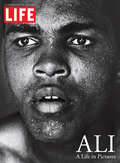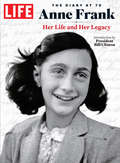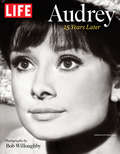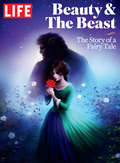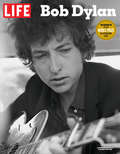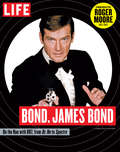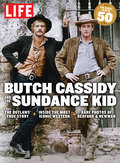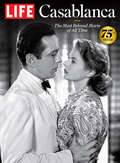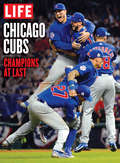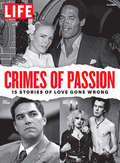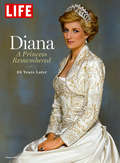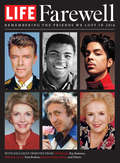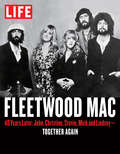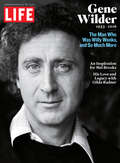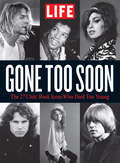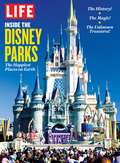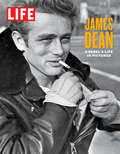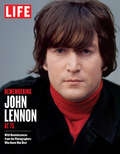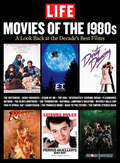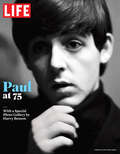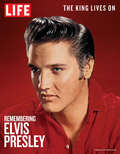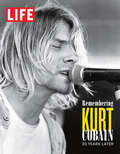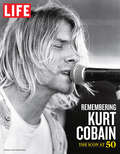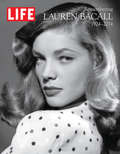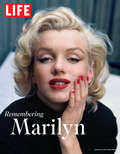- Table View
- List View
LIFE ALI: A Life in Pictures
by The Editors of LifeFor Muhammad Ali, the high drama that he generated within the boxing ring with his athletic prowess was more than matched by the drama that he generated outside of it, and it was stated by many that as the 20th century closed, he was the best known and the most beloved figure in the world. He was also the rare athlete of his day who was photographed equally inside and outside of the ring, and always, the images were striking and compelling.Now, in an all-new special edition, LIFE celebrates the legendary athlete and cultural icon in Ali: A Life in Pictures, featuring dozens of photographs from acclaimed photographers including Gordon Parks, Harry Benson, Marvin Lichtner, James Drake, The Bettman Archive and many more. Many of these images have come to be as synonymous with Ali as his best quotes, and many of these images have not been seen for years.All of the photos are accompanied by essays and commentary that take readers through four distinct stages of Ali's life - "Clay," "Ali," "Legend," and "The Greatest," and all together, Ali: A Life in Pictures is the ultimate commemorative keepsake that celebrates an icon in both words and photographs.
LIFE Anne Frank: Her Life and Her Legacy
by Bill Clinton The Editors of LifeIn 1942, a young girl named Anne Frank was given a diary as a 13th birthday present. In it, she recorded her thoughts and experiences as her family-German Jews living in Amsterdam-went into hiding to attempt to escape the Nazi regime. They were finally found out and did not survive to the end of the war, but the subsequent publication of Anne's moving, mature and often beautiful diary made her into one of the most significant chroniclers of the Holocaust. The diary has been translated into 70 languages, with 25 million copies sold, and the lessons of Anne Frank's life continue to be learned anew every day.Includes:How Adolf Hitler came to power-and how the Frank family realized they would have to go into hidingThe experiences that convinced Anne Frank she was meant to be a writerWhat happened to Anne and her family after they were discoveredThe world's response to the publication of Anne's diary in 1947 and the impact it has had in the seven decades sincePlus: An introduction by President Bill Clinton
LIFE Audrey: 25 Years Later
by The Editors of LIFETwenty-five years after her untimely passing, Audrey Hepburn remains one of Hollywood's most enduring icons of style, grace, and beauty. Remember her with this stunning tribute featuring images by Hepburn's close friend Bob Willoughby, a renowned photojournalist for Life magazine and many other publications.
LIFE Beauty & The Beast: The Story of a Fairy Tale
by The Editors of LIFECelebrating the release of Walt Disney's much-anticipated live-action version of the beloved 1991 animated feature, LIFE delivers the fascinating story behind the fairy tale itself-from its hidden origins as an ancient, sometimes bawdy story told by firesides (did you know the beast was once depicted as a pig?) to its later incarnations as a Brothers Grimm tale, a classic French film, a hit television series-even an opera. Culminating in a behind-the-scenes look at the new musical starring Emma Watson, this is an enchanting look at the enduring power of a story that began "Once upon a time..."
LIFE Bob Dylan
by The Editors of LifeOn the occasion of Bob Dylan becoming the first songwriter to be awarded the Nobel Prize in literature, LIFE presents this updated classic edition of Dylan's illustrious and transformative life. With beautiful and rarely seen photographs and with a deeply engaging narrative the book takes readers from the icon's early days in Minnesota to his emergence onto the New York City folk-rock screen to his rise to the world's most influential singer and poet. There is only one Bob Dylan and through this chronicling of his relationships, his controversial public stances and those unforgettable songs, Dylan comes to life. PLUS: An exclusive appraisal of Dylan's place in the Nobel Prize pantheon.
LIFE Bond. James Bond: Commemorating Roger Moore 1927-2017
by The Editors of LifeNo name is more synonymous with suave sophistication and danger than James Bond. And no actor filled the spy's black calf oxfords more often-or with quite the eyebrow-up charm-than the late Roger Moore. Witty and stylish, Moore, who died in May 2017, embodied the spirit of Ian Fleming's globe-trotting secret agent in Live and Let Die, The Spy Who Loved Me, and five other 007 classics.In LIFE Bond. James Bond we pay tribute to this iconic star and all of the agents who came before and after him-the seminal Sean Connery, George Lazenby, Timothy Dalton, Pierce Brosnan, and Daniel Craig. A special section on the history of the Bond franchise provides rare photographs from on the set and off and yields inside intelligence on each film's behind-the-scenes politics, business deals, and casting calls. Plus: an essay by TIME's acclaimed film and culture critic Richard Corliss examines how Bond reflects and influences the world at large.No matter who your favorite 007 is or which 007 film you like the best, LIFE Bond. James Bond delivers.
LIFE Butch Cassidy and the Sundance Kid at 50
by The Editors of LIFELIFE Magazine presents Butch Cassidy and the Sundance Kid at 50.
LIFE Casablanca: The Most Beloved Movie of All Time
by The Editors of LIFEThis beautiful LIFE Special Edition, commemorating the 75th anniversary of Casablanca, is filled with timeless photos of Humphrey Bogart, Ingrid Bergman, Claude Rains, Dooley Wilson, and other stars of the iconic wartime romance. Go on set and behind the scenes with these memorable images and with compelling, insightful text. Learn about the making of the film that changed the industry, and discover the stories of the actors and creators of the movie-many of whom were refugees from Hitler's oppression, lending authenticity to the film. By delving into enduring moments and lines like "Play it, Sam" and "We'll always have Paris" and "As Time Goes By" and "Here's looking at you, kid," LIFE: Casablanca provides an intimate and inspiring look at one of Hollywood's greatest achievements. Plus: a special look at Casablanca's cultural impact today.
LIFE Chicago Cubs: Champions at Last
by The Editors of LifeCelebrate the Chicago Cubs' historic 2016 World Series championship with this beautifully illustrated 96-page special edition of Life. Through a masterfully-written narrative and unforgettable images explore the long history of the Cubs and the team's emotional intersection with America and larger cultural and political forces. And see how this year's league-leading team lifted sports' most enduring curse in dramatic and thrilling fashion.SPECIAL FEATURES: George F. Will on Wrigley Field, Steve Rushin on eternal Cubhood, Cait Murphy on the 1908 Cub Champions.
LIFE Crimes of Passion: 15 Stories of Love Gone Wrong
by The Editors of LifeLIFE magazine presents stories of crimes of passion.
LIFE Diana: A Princess Remembered
by The Editors of LifeA Princess RememberedEmbrace the lasting legacy of Princess Diana with this keepsake Special Edition, filled with insightful writing and gorgeous photography from the LIFE archives. At her storybook royal wedding in 1981-"The Wedding of the Century"-Diana Spencer seemed the perfect match for Prince Charles, the dashing heir to the British throne. Though their story did not end happily ever after, Diana's talent for truly connecting with people changed the monarchy forever, and her commitment to helping the underprivileged continues to inspire us today. From Prince William and Kate Middleton, to Prince Harry, and even Queen Elizabeth II, England's royal family shows the influence of Diana's bold and brave choices. LIFE Diana offers a touching remembrance of "The People's Princess," 20 years after her tragic death.
LIFE Farewell: Remembering the Friends we Lost in 2016
by The Editors of LifeCelebrating the people we lost in 2016, LIFE's commemorative collector's edition gives an intimate look back at the lives of David Bowie, Prince, Harper Lee, Patty Duke, and many more. Featuring exclusive personal tributes from Tom Brokaw on Nancy Reagan, Susan Lucci on the creator of All My Children, Travis Tritt on Glenn Frey, Billy Ray Cyrus on Merle Haggard, Leslie Stahl on Morley Safer, Ray Romano on Doris Roberts, Mel Brooks on Gene Wilder, and Kareem Abdul-Jabbar on Muhammed Ali.
LIFE Fleetwood Mac: 40 Years Later: John, Christine, Stevie, Mick and Lindsey - Together Again
by The Editors of LifeLIFE Magazine presents a tribute to Fleetwood Mac.
LIFE Gene Wilder, 1933-2016: The Man Who Was Willy Wonka and So Much More
by The Editors of LIFEIn a tribute to Gene Wilder, the movies' first Willy Wonka, LIFE presents a lavishly illustrated commemorative edition. This special issue highlights Wilder's indelible, career-defining roles and traces his life from his childhood in Milwaukee through his marriage to and loss of Saturday Night Live star Gilda Radner and beyond:Behind the scenes at Willy Wonka's chocolate factory, and why Wonka remains such an enduring film for childrenInside Young Frankenstein, Blazing Saddles, and The Producers and Wilder's partnership with director Mel BrooksHow Wilder and Richard Pryor created comedic gold on screenGilda Radner, Wilder's beloved late wife, in her own words
LIFE Gone Too Soon: The 27 Club - Rock Icons Who Died Too Soon
by The Editors of LifeThe story of the 27 club is a one of brilliance: precious, fragile, and amazing to behold. Six musical artists who all happened to die at the same early age-27-did more than perform memorable songs: They expressed ideas and emotions that were shared by enthralled followers from their generations and beyond. The stories of these luminous artist lead to tragic ends. But the lives they led were transformative-to music, to culture, and to countless lives.In Gone Too Soon: The 27 Club, LIFE pulls you into the brief and explosive lives of musicians Brian Jones, Jimi Hendrix, Janis Joplin, Jim Morrison, Kurt Cobain, and Amy Winehouse through photographs and interviews. Read how Hendrix uniquely mashed together blues and rock into a paisley-patterned kaleidoscope of sound, look at images of Cobain's infamous MTV Unplugged special and much more. The legacy of these artists still lives and breathes onstage, embodied by musicians who looked to these icons for inspiration.
LIFE Inside the Disney Parks: The Happiest Places on Earth
by The Editors of LIFEWalt Disney spent his life dreaming impossible dreams, and achieved the most impossible dream of all - the amusement park to end all amusement parks: Disneyland!
LIFE James Dean: A Rebel's Life in Pictures
by The Editors of LifeLIFE Magazine memorializes actor James Dean.
LIFE Movies of the 1980s: A Look Back at the Decade's Best Films
by The Editors of LIFETravel back to the future with dozens of 1980s favoritesBefore the internet, in the days of Rubik's Cubes, the Iran-Contra scandal, and Wall Street's booms and busts, movies captured the spirit of our times. Now you can revisit those great films with LIFE Movies of the 1980s, packed with glowing photos and behind-the-scenes stories from the pages of Life magazine.
LIFE Paul at 75
by The Editors of Life Tony SchermanLIFE celebrates the 75th birthday of renowned musician Sir Paul McCartney.
LIFE Remembering Elvis Presley: The King Lives On
by The Editors of LifeHe will always be the KingCelebrate the King of Rock 'n' Roll with this keepsake biography of Elvis Presley, lavishly illustrated with dozens of historic photos, including many from the archives of Life magazine. A detailed timeline traces Elvis's life from when he received his first guitar to his glory days filled with recording, acting and gyrating for shrieking fans, to his great '68 comeback comeback, and right up to his untimely death in 1977. Intimate photojournalism combines with insightful text to reveal Elvis behind the scenes . . . at Graceland and on the road, with Priscilla and Lisa Marie, in front of the cameras, and on the stage. Explore the days of "Heartbreak Hotel," "Don't Be Cruel," "Blue Suede Shoes," "Jailhouse Rock," "Love Me Tender," "Blue Christmas" and so many other unforgettable hits. It's now or never-so you should probably pick up your copy today.
LIFE Remembering Kurt Cobain: 20 Years Later
by The Editors of LifeLIFE Magazine remembers Nirvana's Kurt Cobain.
LIFE Remembering Kurt Cobain: The Icon at 50
by The Editors of LifeLIFE Magazine remembers Nirvana's Kurt Cobain.
LIFE Remembering Lauren Bacall, 1924-2014 (LIFE Special Issue Magazine)
by The Editors of LIFELIFE Magazine remembers actress Lauren Bacall.
LIFE Remembering Marilyn
by The Editors of LifeRemembering the iconic star through intimate photos and essaysMore than fifty years after her death, Marilyn Monroe remains as famous as ever. Rediscover the screen legend with dozens of intimate photos from the archives of LIFE magazine. Insightful text reveals Monroe's journey from Norma Jeane to international star and American icon. Includes special access to the famous "Happy Birthday, Mr. President" performance for John F. Kennedy as well as the more than 30 movie roles that made her an icon. Some Like It Hot . . . The Seven-Year Itch . . . Gentlemen Prefer Blondes . . . The Misfits . . . these classic movies and her performances in them made her one of Hollywood's most glamorous stars. Her personal life, with marriages to Arthur Miller and Joe DiMaggio, and rumored affairs with John F. Kennedy and Bobby Kennedy, made her fascinating. LIFE Remembering Marilyn lets readers see Monroe's remarkable life both in front of the cameras and behind the scenes.
